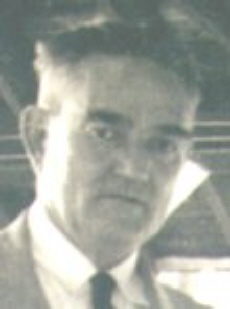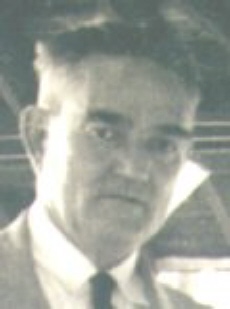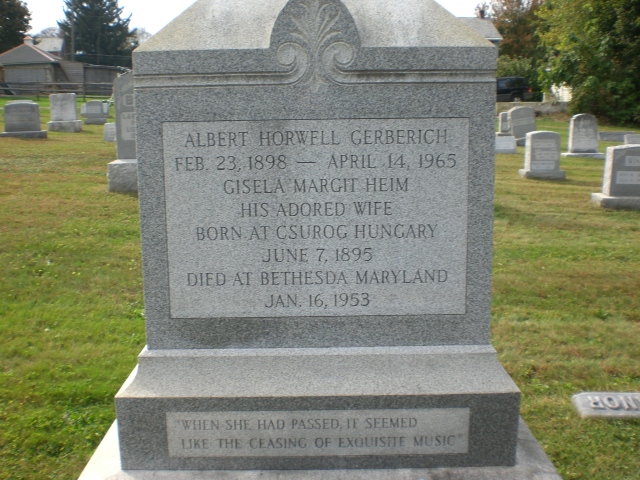Compiler and publisher of the 1925 History of the Gerberichs in America
He was employed as a newspaper reporter, and in the steel works as an oxy-acetylene burner, and in 1918 graduated from Dickinson College. On May 17, 1918, he enlisted in the United States Navy and served as a radio electrician till Feb. 10, 1919. After examination, May 12, 1919, he was appointed Vice Consul de Carriere of the United States and was in charge of the Consulate at Puerto Cortes, Honduras, till April 7, 1922, later serving at Bremerhaven, Germany, as Vice Consul, and at Maracaibo, Venezuela, as Consul. He is a member of the Masonic fraternity and of the Phi Beta Kappa Society. [History of the Gerberichs in America]
Sep 1965: The Society announces with deep regret the passing of its member of 35 years, Dr. Albert Horwell Gerberich. His death took place at Sibley Hospital, Washington, DC, 14 April 1965. Dr. Gerberich was born in Williamstown, Dauphin County, PA, 23 February 1898, as the only son of Albert Henry Gerberich and his wife, Martha Eleanor Horwell. The ancestry of the Gerberichs has been traced to Hans Gerberich (1613-81) of Altfeld bei Marktheidenfeld, parish of Michelrieth, Bavaria; they came to Pennsylvania in three migrations, 1751, 1752 and 1754. Other pioneer ancestors included Melchoir Brenneman (son of a Swiss Mennonite exile of the same name), who settled in Chester County, Pennsylvania by 1717; and Daniel Stauffer, of Warwick Township, Lancaster County, Pennsylvania. Dr. Gerberich's mother was a native of Tunstall, Staffordshire, England; her father, Rev. Samuel Horwell (1837-1923), was a Methodist clergyman in Pennsylvania. Dr. Gerberich was educated at the Parkesburg (Chester Co, PA) High School (graduated 1914), Dickinson College (A.B., 1918), the University of Pennsylvania (M.A., 1926), and Johns Hopkins University (Ph.D., 1932). In his doctorial dissertation, Luther and the English Bible, (1933), he demonstrated the influence of the great German reformer on the English translation of the Bible by the martyred William Tyndale as well as in the later Kings James version. In the summer of 1930, he attended the German School at Western Reserve University, Cleveland, Ohio, and the next summer the Linguistic Institute of America, New York City. His career may be summed up as follows: Radio electrician, U.S. Navy, 1918-19; entered the Foreign Service, 1919, serving as Vice-Counsel, Puerto Cortes, Honduros, 1920-22; Vice Counsel and later Counsel, Bremerhaven, Germany, 1922-24; Counsel, Maracaibo, Venezuela, 1924-25 (resigned); Head of Latin Department, Coatesville (Chester Co, PA) High School, 1926-28, Professor of Modern Languages, Dickinson College, Carlisle, PA, 1928-41; re-entered the Foreign Service, serving as Junior Cultural Relations Assistant and later Cultural Relations Attache, Bogota, Columbia, 1944-46; and, Finally, Officer-in-Charge of Colombian Affairs, Department of State, Washington, DC until his retirement in 1960. From his early years, Dr. Gerberich was interested in genealogical research, quickly establishing himself as the country's foremost authority on the Pennsylvania Germans, their history, families and migrations. He spent years visiting cemeteries and copying inscriptions, examining census records not only of Pennsylvania but of many other states to which the Pennsylvania Germans had migrated, collecting Bible records, transcribing church registers and interviewing people who had knowledge of earlier generations. He studied published genealogies and local histories and denounced those that laid claim to false and fabulous origins. The writer recalls that in an address before this Society, Dr. Gerberich roundly denounced the Zeller family's allegation that their immigrant ancestress was "clothilde de Valois", showing that she bore instead the very prosaic name of Anna Catharina (maiden surname unknown) and died at Tulpehocken, Berks Co, PA in 1749. Nothing made Dr. Gerberich so impatient as the ridiculous statements of unproved noble and royal origins put forth on behalf of Pennsylvania German families. His own published genealogies, on the Gerberich (in collaboration with his father in 1925), the Brennemans (1938) and the Backenstoss family (1949) are models of genealogical compilation. Dr. Gerberich's plan had been to compile and publish a Pennsylvania German genealogical encyclopedia but he never lived to complete it. His files, which he bequeathed to the Genealogical Society of Pennsylvania, contains records and notebooks dealing with thousands of persons from the 18th century onward. He became a member of the National Genealogical Society in 1928 while living in Pennsylvania. After he made Washington his permanent home, he took a keen and active interest in its affairs for a number of years, and during the present writer's administration, served as Vice-President (1947-48). He was an old friend of the late distinguished Editor of the Quarterly, Dr. Gaius M. Brumbaugh, and contributed to the pages of our magazine Bible records of the families Roesser (Raysor), Brenneman, Neely, Rohrer and others, and tombstone inscriptions from Old Walmer's Cemetery, Lebanon Co, Pa, the Harry Lantz Fehl farm's graveyard, Conestoga Twp, Lancaster Co, PA, and Brownbacks' Church, Chester Co, PA. He made significant contributions to our knowledge of Latin American branches of North American families in his articles. Dr. Gerberich was an Honorary Life Member of the Genealogical Society of Pennsylvania since 7 March 1932, this honor having been granted "in recognition of his offer to supply 5,000 tombstone inscriptions from cemeteries to be designated by the Board". He was also a member of the Pennsylvania German Society, the Huguenot Society of Pennsylvania, and (formerly) the Pennsylvania Historical Junto of Washington, DC. He was a Mason and a member of the Phi Beta Kappa fraternity, and a Methodist. He was one of the first instructors of the American University's Institute of Genealogical Research founded in 1950. In recognition of his services in the field of Pennsylvania German genealogy, he was elected a Fellow of The American Society of Genealogists on 27 June 1944. His interests ranged far and wide. He was a deeply religious man who was much interested in the history of the Christian Church, especially during the first centuries of our era. He read extensively works on literature and art. He was a linguist, being thoroughly at home in English, German, Spanish, Latin and Greek, could read Swedish, and at one time studied Sanskrit, the literary language of India, out of sheer curiosity. The writer has evidence that at one time, Dr. Gerberich's curiosity led him to explore the mysteries of Egyptian hieroglyphics. On 21 June 1934, at Tionesta, Pennsylvania, he married Gisela Margit Heim-Zimanyi, who was born at Csurog in the Bacskak, Hungary, 7 June 1898, and died at their home, 7912 Radnor Road, Bethesda, Maryland 16 January 1953. Mrs. Gerberich was a talented ceramic artist. In 1935 he published "Essays in Verse", in which the first and last poems are written to her. Several of his verses have an historic or literary basis such as "To John Huss", "To John Greenleaf Whittier", "At the Tomb of Washington", "The Brownings", "To Upton Sinclair", "At the Statue of Francis Asbury", "The Puritans", etc. "At Walmers Church" expresses his great reverence for the Pennsylvania Germans. Standing in the graveyard he thought: "Here read the names of nobles who have passed Into that realm whence they return no more; Walmer and Gerberich, Shuey, Schreckengast, Alberthal, Hetrich, Backenstoss, Boeshore, Pfatteicher, Batdorf, Rieth, Theiss, Bartelmay, And others carved on stones less permanent - I love you all! And on this fragile day Beneath the blue unclouded firmament I could sink down and kiss this earth so dear, And, grateful, bless those lives that vanished here." Albert H. Gerberich was not a prolific writer, but his few books and articles testify to the soundness of his research. His vast manuscript collection will be preserved for those interested researchers of Pennsylvania German families. His sole immediate survivor is his 101 year old father, Albert H. Gerberich, now of 8261 29th Avenue, North, St. Petersburg, Fla, 33710, to whom the Society extends its deepest sympathy. [National Genealogical Quarterly/Milton Rubincam]
Compiler and publisher of the 1925 History of the Gerberichs in America
He was employed as a newspaper reporter, and in the steel works as an oxy-acetylene burner, and in 1918 graduated from Dickinson College. On May 17, 1918, he enlisted in the United States Navy and served as a radio electrician till Feb. 10, 1919. After examination, May 12, 1919, he was appointed Vice Consul de Carriere of the United States and was in charge of the Consulate at Puerto Cortes, Honduras, till April 7, 1922, later serving at Bremerhaven, Germany, as Vice Consul, and at Maracaibo, Venezuela, as Consul. He is a member of the Masonic fraternity and of the Phi Beta Kappa Society. [History of the Gerberichs in America]
Sep 1965: The Society announces with deep regret the passing of its member of 35 years, Dr. Albert Horwell Gerberich. His death took place at Sibley Hospital, Washington, DC, 14 April 1965. Dr. Gerberich was born in Williamstown, Dauphin County, PA, 23 February 1898, as the only son of Albert Henry Gerberich and his wife, Martha Eleanor Horwell. The ancestry of the Gerberichs has been traced to Hans Gerberich (1613-81) of Altfeld bei Marktheidenfeld, parish of Michelrieth, Bavaria; they came to Pennsylvania in three migrations, 1751, 1752 and 1754. Other pioneer ancestors included Melchoir Brenneman (son of a Swiss Mennonite exile of the same name), who settled in Chester County, Pennsylvania by 1717; and Daniel Stauffer, of Warwick Township, Lancaster County, Pennsylvania. Dr. Gerberich's mother was a native of Tunstall, Staffordshire, England; her father, Rev. Samuel Horwell (1837-1923), was a Methodist clergyman in Pennsylvania. Dr. Gerberich was educated at the Parkesburg (Chester Co, PA) High School (graduated 1914), Dickinson College (A.B., 1918), the University of Pennsylvania (M.A., 1926), and Johns Hopkins University (Ph.D., 1932). In his doctorial dissertation, Luther and the English Bible, (1933), he demonstrated the influence of the great German reformer on the English translation of the Bible by the martyred William Tyndale as well as in the later Kings James version. In the summer of 1930, he attended the German School at Western Reserve University, Cleveland, Ohio, and the next summer the Linguistic Institute of America, New York City. His career may be summed up as follows: Radio electrician, U.S. Navy, 1918-19; entered the Foreign Service, 1919, serving as Vice-Counsel, Puerto Cortes, Honduros, 1920-22; Vice Counsel and later Counsel, Bremerhaven, Germany, 1922-24; Counsel, Maracaibo, Venezuela, 1924-25 (resigned); Head of Latin Department, Coatesville (Chester Co, PA) High School, 1926-28, Professor of Modern Languages, Dickinson College, Carlisle, PA, 1928-41; re-entered the Foreign Service, serving as Junior Cultural Relations Assistant and later Cultural Relations Attache, Bogota, Columbia, 1944-46; and, Finally, Officer-in-Charge of Colombian Affairs, Department of State, Washington, DC until his retirement in 1960. From his early years, Dr. Gerberich was interested in genealogical research, quickly establishing himself as the country's foremost authority on the Pennsylvania Germans, their history, families and migrations. He spent years visiting cemeteries and copying inscriptions, examining census records not only of Pennsylvania but of many other states to which the Pennsylvania Germans had migrated, collecting Bible records, transcribing church registers and interviewing people who had knowledge of earlier generations. He studied published genealogies and local histories and denounced those that laid claim to false and fabulous origins. The writer recalls that in an address before this Society, Dr. Gerberich roundly denounced the Zeller family's allegation that their immigrant ancestress was "clothilde de Valois", showing that she bore instead the very prosaic name of Anna Catharina (maiden surname unknown) and died at Tulpehocken, Berks Co, PA in 1749. Nothing made Dr. Gerberich so impatient as the ridiculous statements of unproved noble and royal origins put forth on behalf of Pennsylvania German families. His own published genealogies, on the Gerberich (in collaboration with his father in 1925), the Brennemans (1938) and the Backenstoss family (1949) are models of genealogical compilation. Dr. Gerberich's plan had been to compile and publish a Pennsylvania German genealogical encyclopedia but he never lived to complete it. His files, which he bequeathed to the Genealogical Society of Pennsylvania, contains records and notebooks dealing with thousands of persons from the 18th century onward. He became a member of the National Genealogical Society in 1928 while living in Pennsylvania. After he made Washington his permanent home, he took a keen and active interest in its affairs for a number of years, and during the present writer's administration, served as Vice-President (1947-48). He was an old friend of the late distinguished Editor of the Quarterly, Dr. Gaius M. Brumbaugh, and contributed to the pages of our magazine Bible records of the families Roesser (Raysor), Brenneman, Neely, Rohrer and others, and tombstone inscriptions from Old Walmer's Cemetery, Lebanon Co, Pa, the Harry Lantz Fehl farm's graveyard, Conestoga Twp, Lancaster Co, PA, and Brownbacks' Church, Chester Co, PA. He made significant contributions to our knowledge of Latin American branches of North American families in his articles. Dr. Gerberich was an Honorary Life Member of the Genealogical Society of Pennsylvania since 7 March 1932, this honor having been granted "in recognition of his offer to supply 5,000 tombstone inscriptions from cemeteries to be designated by the Board". He was also a member of the Pennsylvania German Society, the Huguenot Society of Pennsylvania, and (formerly) the Pennsylvania Historical Junto of Washington, DC. He was a Mason and a member of the Phi Beta Kappa fraternity, and a Methodist. He was one of the first instructors of the American University's Institute of Genealogical Research founded in 1950. In recognition of his services in the field of Pennsylvania German genealogy, he was elected a Fellow of The American Society of Genealogists on 27 June 1944. His interests ranged far and wide. He was a deeply religious man who was much interested in the history of the Christian Church, especially during the first centuries of our era. He read extensively works on literature and art. He was a linguist, being thoroughly at home in English, German, Spanish, Latin and Greek, could read Swedish, and at one time studied Sanskrit, the literary language of India, out of sheer curiosity. The writer has evidence that at one time, Dr. Gerberich's curiosity led him to explore the mysteries of Egyptian hieroglyphics. On 21 June 1934, at Tionesta, Pennsylvania, he married Gisela Margit Heim-Zimanyi, who was born at Csurog in the Bacskak, Hungary, 7 June 1898, and died at their home, 7912 Radnor Road, Bethesda, Maryland 16 January 1953. Mrs. Gerberich was a talented ceramic artist. In 1935 he published "Essays in Verse", in which the first and last poems are written to her. Several of his verses have an historic or literary basis such as "To John Huss", "To John Greenleaf Whittier", "At the Tomb of Washington", "The Brownings", "To Upton Sinclair", "At the Statue of Francis Asbury", "The Puritans", etc. "At Walmers Church" expresses his great reverence for the Pennsylvania Germans. Standing in the graveyard he thought: "Here read the names of nobles who have passed Into that realm whence they return no more; Walmer and Gerberich, Shuey, Schreckengast, Alberthal, Hetrich, Backenstoss, Boeshore, Pfatteicher, Batdorf, Rieth, Theiss, Bartelmay, And others carved on stones less permanent - I love you all! And on this fragile day Beneath the blue unclouded firmament I could sink down and kiss this earth so dear, And, grateful, bless those lives that vanished here." Albert H. Gerberich was not a prolific writer, but his few books and articles testify to the soundness of his research. His vast manuscript collection will be preserved for those interested researchers of Pennsylvania German families. His sole immediate survivor is his 101 year old father, Albert H. Gerberich, now of 8261 29th Avenue, North, St. Petersburg, Fla, 33710, to whom the Society extends its deepest sympathy. [National Genealogical Quarterly/Milton Rubincam]
Family Members
Sponsored by Ancestry
Advertisement
Advertisement













